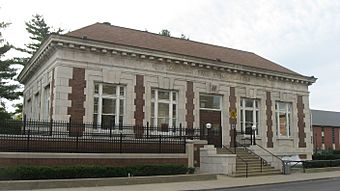Louisville Free Public Library, Western Branch facts for kids
Quick facts for kids |
|
|
Louisville Free Public Library, Western Colored Branch
|
|

Front of the library
|
|
| Location | 604 S. 10th St., Louisville, Kentucky |
|---|---|
| Area | less than one acre |
| Built | 1907 |
| Architect | McDonald & Dodd; Lortz & Frey Planing Mill Co. |
| Architectural style | Beaux Arts |
| NRHP reference No. | 75000771 |
| Added to NRHP | December 6, 1975 |
The Western Library in Louisville, Kentucky, is a special public library. It was the very first public library built just for African Americans that was also run entirely by African American staff. This library is a type of building called a Carnegie library, which means it got money from a famous rich person, Andrew Carnegie. It's officially known as the Louisville Free Public Library, Western Colored Branch and is listed on the National Register of Historic Places because it's so important.
Contents
A Library for Everyone
The Western Colored Branch library first opened in September 1905. It was originally located at 1125 West Chestnut Street. Back then, many libraries for Black communities were in rented rooms or changed private homes. When this library first started, it was in three rented rooms inside a private house.
How the Library Started
Albert Ernest Meyzeek was the principal of Central High School. He noticed that his school did not have enough good books or study materials. He felt that the city's library system, created in 1902, did not serve African Americans fairly.
So, Mr. Meyzeek convinced the city council to open a library branch to help fill this need. He later also pushed for a second library for Black people, called the Eastern Colored Branch. That library opened in 1914.
Andrew Carnegie's Gift
In 1908, a very rich businessman named Andrew Carnegie gave money to build a new library building. Because of his gift, the Western Colored Branch became the first public library for African Americans in the southern United States that was built with Carnegie's money. The new library building was designed by a company called McDonald & Dodd.
The building is about 75 feet long and 45 feet wide. It is made of brick with stone decorations. The community loved the new library. It showed how much the Black middle class in the South wanted to build good things for their communities. They wanted to help improve life for everyone.
A Center for Community
Several important African American librarians worked at the Western Branch. They helped with education and outreach programs for the local Black community. Two very important people were Reverend Thomas Fountain Blue and Rachel Davis Harris. Reverend Blue was in charge of both the Western and Eastern Colored Branches. Rachel Davis Harris was the children's library expert and a main assistant.
Blue and Harris were very important in helping Louisville's African American community. This was during a time when laws kept Black and white people separate, known as the Jim Crow era. In 1917, about 12,000 people attended 498 meetings at both library branches.
More Than Just Books
Reverend Blue created a plan to reach out to the community. He said the library was much more than just a place to keep books. He believed it was a place with reading rooms, study rooms, and classrooms. He said it was a "center from which radiate many influences for general betterment." He wanted people to feel that the library belonged to them. They could use it for anything that helped them.
The Western and Eastern branches became important social centers for the community. They became examples for other libraries like them. The library had a Children's Department. This department held story times, debates, and special events. The library also had an annual spelling bee. Winners received cups and cash prizes from Joseph S. Cotter, a local Black educator. The famous Douglass Debate Club for high school boys also used this branch. They often debated topics about civil rights.
The library also helped set up book collections in classrooms. They created forty collections at eleven African American schools in the city and county. By 1935, this grew to eighty classroom collections. They also offered library services at two junior high schools. Plus, they set up 15 deposit stations, which were like mini-libraries in other places.
From 1912 to 1931, Reverend Blue also taught a class for people who wanted to become librarians. This was the only way for Black people to get formal training to become librarians. This was true until the Hampton Library School opened in Virginia in 1925.
Recent Years
The library was added to the National Register of Historic Places in 1975. This means it is recognized as an important historic site. In 2001, the musician Prince secretly gave $12,000 to help keep the library from closing.



